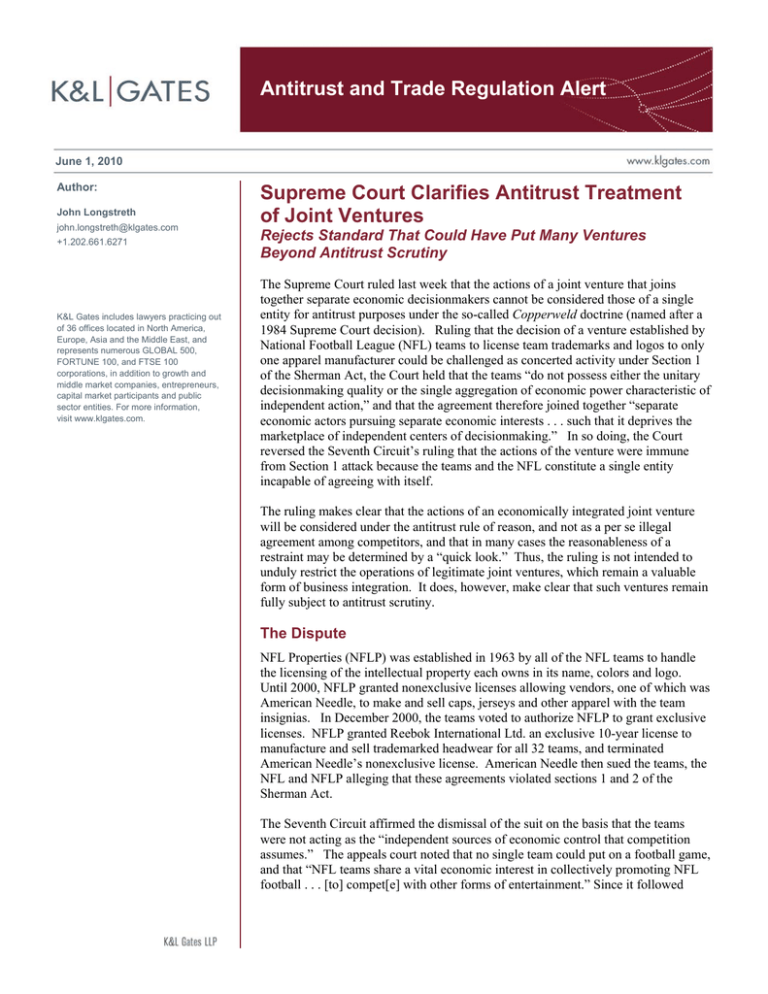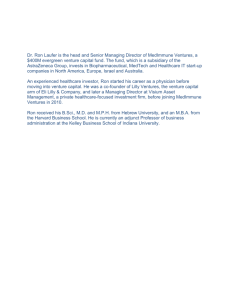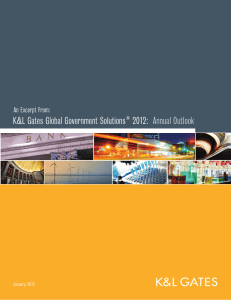
Antitrust and Trade Regulation Alert
June 1, 2010
Author:
John Longstreth
john.longstreth@klgates.com
+1.202.661.6271
K&L Gates includes lawyers practicing out
of 36 offices located in North America,
Europe, Asia and the Middle East, and
represents numerous GLOBAL 500,
FORTUNE 100, and FTSE 100
corporations, in addition to growth and
middle market companies, entrepreneurs,
capital market participants and public
sector entities. For more information,
visit www.klgates.com.
Supreme Court Clarifies Antitrust Treatment
of Joint Ventures
Rejects Standard That Could Have Put Many Ventures
Beyond Antitrust Scrutiny
The Supreme Court ruled last week that the actions of a joint venture that joins
together separate economic decisionmakers cannot be considered those of a single
entity for antitrust purposes under the so-called Copperweld doctrine (named after a
1984 Supreme Court decision). Ruling that the decision of a venture established by
National Football League (NFL) teams to license team trademarks and logos to only
one apparel manufacturer could be challenged as concerted activity under Section 1
of the Sherman Act, the Court held that the teams “do not possess either the unitary
decisionmaking quality or the single aggregation of economic power characteristic of
independent action,” and that the agreement therefore joined together “separate
economic actors pursuing separate economic interests . . . such that it deprives the
marketplace of independent centers of decisionmaking.” In so doing, the Court
reversed the Seventh Circuit’s ruling that the actions of the venture were immune
from Section 1 attack because the teams and the NFL constitute a single entity
incapable of agreeing with itself.
The ruling makes clear that the actions of an economically integrated joint venture
will be considered under the antitrust rule of reason, and not as a per se illegal
agreement among competitors, and that in many cases the reasonableness of a
restraint may be determined by a “quick look.” Thus, the ruling is not intended to
unduly restrict the operations of legitimate joint ventures, which remain a valuable
form of business integration. It does, however, make clear that such ventures remain
fully subject to antitrust scrutiny.
The Dispute
NFL Properties (NFLP) was established in 1963 by all of the NFL teams to handle
the licensing of the intellectual property each owns in its name, colors and logo.
Until 2000, NFLP granted nonexclusive licenses allowing vendors, one of which was
American Needle, to make and sell caps, jerseys and other apparel with the team
insignias. In December 2000, the teams voted to authorize NFLP to grant exclusive
licenses. NFLP granted Reebok International Ltd. an exclusive 10-year license to
manufacture and sell trademarked headwear for all 32 teams, and terminated
American Needle’s nonexclusive license. American Needle then sued the teams, the
NFL and NFLP alleging that these agreements violated sections 1 and 2 of the
Sherman Act.
The Seventh Circuit affirmed the dismissal of the suit on the basis that the teams
were not acting as the “independent sources of economic control that competition
assumes.” The appeals court noted that no single team could put on a football game,
and that “NFL teams share a vital economic interest in collectively promoting NFL
football . . . [to] compet[e] with other forms of entertainment.” Since it followed
Antitrust and Trade Regulation Alert
“that only one source of economic power controls
the promotion of NFL football,” the appeals court
held that the NFLP venture was properly analyzed as
a single enterprise and not as a combination of its
members, which meant that the agreement-amongseparate-actors element of Section 1 was not
satisfied and the case properly dismissed.
American Needle petitioned for review to the
Supreme Court and, in an unusual move given that it
was the winner below, the NFL cross-petitioned to
resolve a conflict in the circuits on the “single
enterprise” issue.
The Decision
The Supreme Court decided only the issue whether
the NFL defendants were capable of engaging in the
concerted activity required under Section 1, or
whether their conduct “must be viewed as that of a
single enterprise for purposes of §1.” (citing
Copperweld Corp. v. Independence Tube Corp., 467
U. S. 752, 771 (1984)). The Court found the
defendants capable of entering into such an
agreement, but did not consider whether the
challenged agreements violated Section 1 as an
unreasonable restraint of trade. That must now be
decided by the trial court under a rule of reason
analysis.
To determine whether the teams, the NFL, and
NFLP acted as a single enterprise, the Court engaged
in a “functional consideration of how the parties
involved in the alleged anticompetitive conduct
actually operate.” The Court noted that such a
functional approach had led to its holding in
Copperweld that “an internal agreement to
implement a single, unitary firm’s policies does not
raise the antitrust dangers that Section 1 was
designed to police.” The question is not whether
one or many distinct legal entities are involved, but
whether the agreement “joins together independent
centers of decisionmaking.” NFL teams have a
common interest in promoting the NFL brand, “but
they are still separate, profit-maximizing entities,
and their interests in licensing team trademarks are
not necessarily aligned.”
In reaching this conclusion, the Court noted that the
teams compete to attract fans, for gate receipts and
for contracts with managerial and playing personnel.
To an apparel manufacturer, each team is a
potentially competing supplier of valuable
trademarks, and thus in licensing their property the
teams are not pursuing the common interests of the
whole league, but, instead, the interests of each
corporation itself. Although the teams have to work
together as a league to create value in each brand, "a
nut and a bolt can only operate together, but an
agreement between nut and bolt manufacturers is
still subject to §1." The need to cooperate is a
factor relevant to whether the agreement is lawful or
not under a rule of reason analysis, but is not
relevant to determining if action is unitary or
concerted. In any event, the Court found that “even
if league-wide agreements are necessary to produce
football, it does not follow that concerted activity in
marketing intellectual property is necessary to
produce football.”
The ruling with respect to the NFL teams applied to
the NFLP as well. Its status as a separate venture
did not change the analysis, since if “the fact that
potential competitors shared in profits or losses
from a venture meant that the venture was immune
from §1,” then any cartel “could evade the antitrust
law simply by creating a ‘joint venture' to serve as
the exclusive seller of their competing products.”
The Court concluded by noting that the venture was
not “trapped by antitrust law.” "When “restraints
on competition are essential if the product is to be
available at all,” per se rules of illegality are
inapplicable, and instead the restraint will be judged
according to the flexible rule of reason And
depending on its nature, the concerted activity may
be approved without a detailed analysis; the rule of
reason “can sometimes be applied in the twinkling
of an eye.” For example, here the league’s interest
in maintaining a competitive balance among teams
is “legitimate and important,” even if it does not
justify treating the teams as a single entity under
Section 1 as to marketing of their individually
owned intellectual property. Analysis thus depends
on the specific nature of the restraint at issue.
Implications
The Court’s decision offers a useful clarification of
the application to joint ventures of the principles of
Copperweld distinguishing unilateral from
concerted activity. The Court’s reaffirmation that
economic realities rather than legal formalisms
should govern is welcome, but by declining to adopt
June 1, 2010
2
Antitrust and Trade Regulation Alert
any bright line rule as to when joint ventures can be
considered a single entity, the Court has apparently
concluded that some increase in litigation is an
acceptable price to allow fuller analysis of
challenged restraints. The result is that joint ventures
may face increased litigation as to restraints that are
ultimately determined not to have anticompetitive
effects. The Court also did not clarify how the rule
of reason should be applied to a venture once
concerted activity is found. The Court reminded that
concerted activity has often been found when
competitors were part of professional organizations
or trade groups.
venture itself or is necessary to its functioning--for
example, the pricing of output of a petroleum
marketing venture where the venturers had divested
their marketing assets to the venture. (Texaco Inc.
v. Dagher (2006)). Here, the Court’s conclusion
appears to have been influenced by its view that the
joint licensing at issue was not necessary to create
and present football games. In any event, the
decision makes clear that careful case-by-case
analysis is required to determine the antitrust
treatment of restraints imposed by joint ventures
and that integration will not alone remove joint
ventures from the shadow of Section 1.
The Court did not find it necessary to rule on the
position presented by the government (as amicus)
that entities should be deemed incapable of
conspiring under §1 if they “have effectively merged
the relevant aspect of their operations, thereby
eliminating actual and potential competition . . . in
that operational sphere” and “the challenged
restraint [does] not significantly affect actual or
potential competition . . . outside their merged
operations.” The Court found that the challenged
NFL licensing activity would be concerted even
under this test, since each entity still owns its own
trademarks and is free to market those trademarks as
it sees fit. The “effective merger” approach thus
might be adopted in different circumstances.
Finally, where a firm owns more than 50% of a joint
venture, it is generally safe to assume that
Copperweld prevents any claim of conspiracy
between that firm and the joint venture. In that
situation, there would be a sufficient “unity of
interest” to preclude any claim of conspiracy, and
nothing in the American Needle decision suggests
otherwise. (The factual context there was of course
very different, for no single team owns more than a
small fraction of NFLP.) At the same time, it
cannot be assumed that Copperweld necessarily
would apply to the relationship between the joint
venture and firms that own less than 50%, or the
relationship between the principals. It might apply,
but as American Needle demonstrates, that question
turns on the specific facts at hand.
The Court has been more accepting in the past of
joint venture activity that must be undertaken by the
Anchorage Austin Beijing Berlin Boston Charlotte Chicago Dallas Dubai Fort Worth Frankfurt Harrisburg Hong Kong London
Los Angeles Miami Moscow Newark New York Orange County Palo Alto Paris Pittsburgh Portland Raleigh Research Triangle Park
San Diego San Francisco Seattle Shanghai Singapore Spokane/Coeur d’Alene Taipei Tokyo Warsaw
Washington, D.C.
K&L Gates includes lawyers practicing out of 36 offices located in North America, Europe, Asia and the Middle East, and represents numerous
GLOBAL 500, FORTUNE 100, and FTSE 100 corporations, in addition to growth and middle market companies, entrepreneurs, capital market
participants and public sector entities. For more information, visit www.klgates.com.
K&L Gates is comprised of multiple affiliated entities: a limited liability partnership with the full name K&L Gates LLP qualified in Delaware and
maintaining offices throughout the United States, in Berlin and Frankfurt, Germany, in Beijing (K&L Gates LLP Beijing Representative Office), in
Dubai, U.A.E., in Shanghai (K&L Gates LLP Shanghai Representative Office), in Tokyo, and in Singapore; a limited liability partnership (also named
K&L Gates LLP) incorporated in England and maintaining offices in London and Paris; a Taiwan general partnership (K&L Gates) maintaining an
office in Taipei; a Hong Kong general partnership (K&L Gates, Solicitors) maintaining an office in Hong Kong; a Polish limited partnership (K&L
Gates Jamka sp. k.) maintaining an office in Warsaw; and a Delaware limited liability company (K&L Gates Holdings, LLC) maintaining an office in
Moscow. K&L Gates maintains appropriate registrations in the jurisdictions in which its offices are located. A list of the partners or members in each
entity is available for inspection at any K&L Gates office.
This publication is for informational purposes and does not contain or convey legal advice. The information herein should not be used or relied upon
in regard to any particular facts or circumstances without first consulting a lawyer.
©2010 K&L Gates LLP. All Rights Reserved.
June 1, 2010
3






